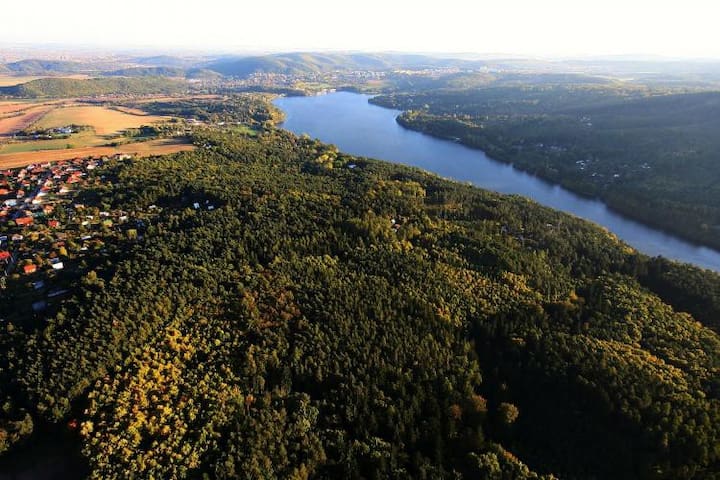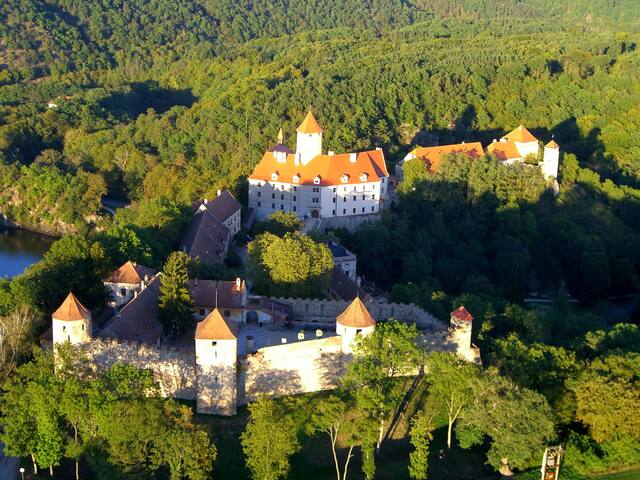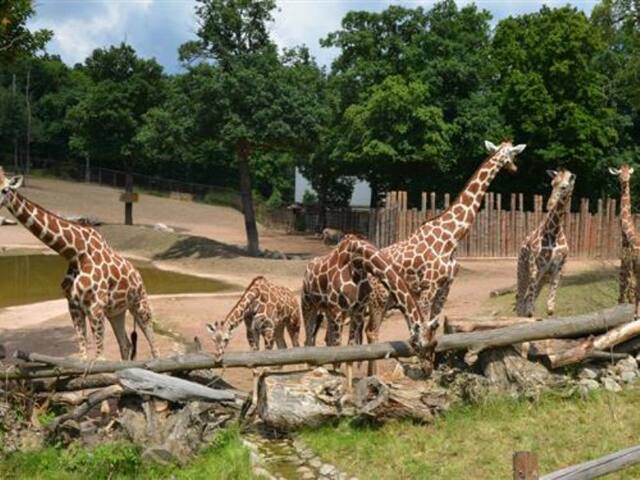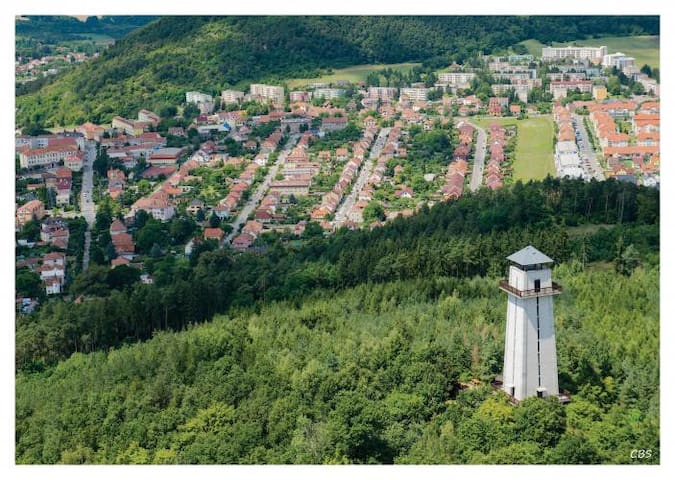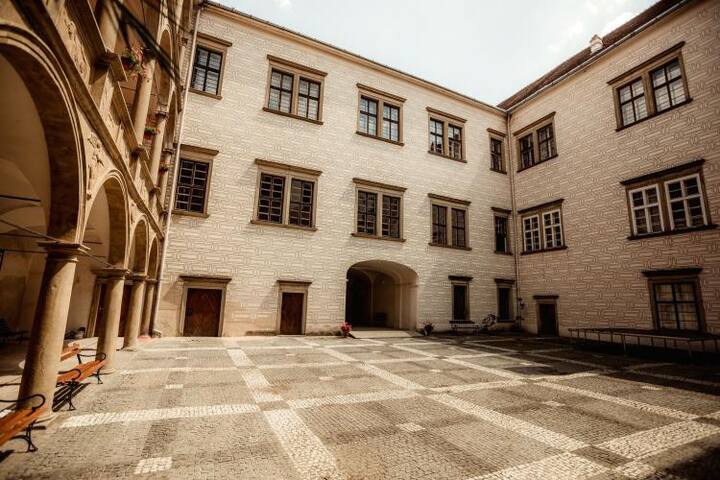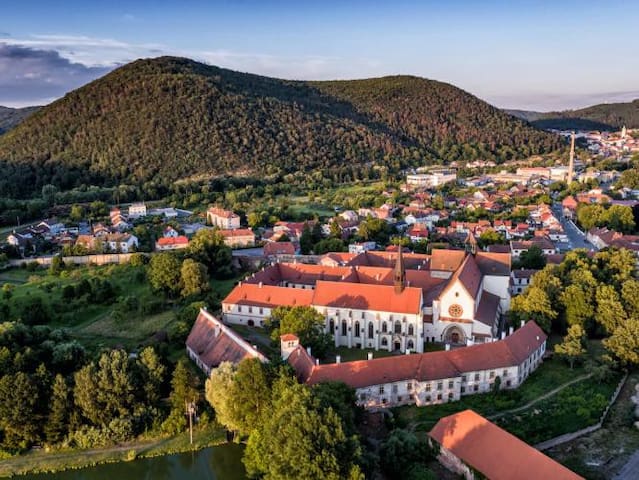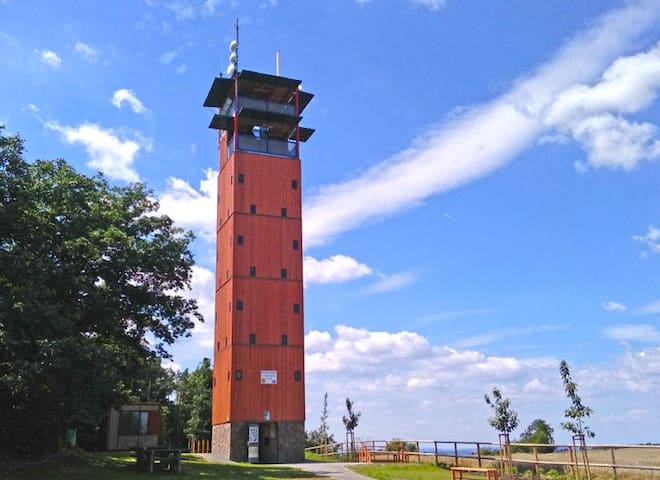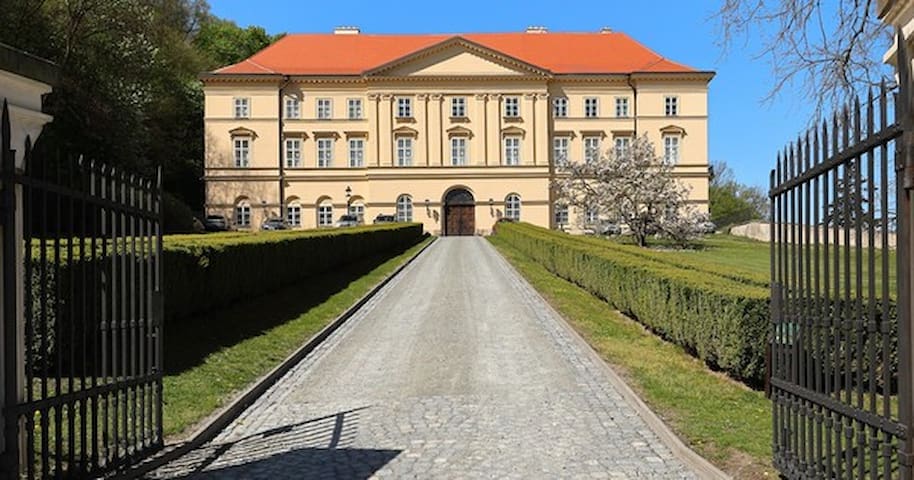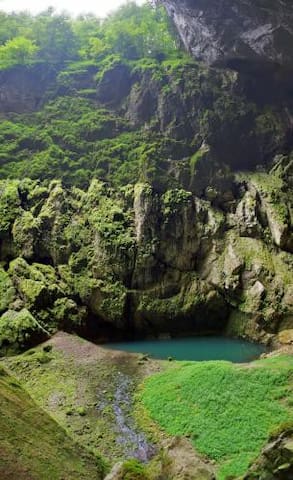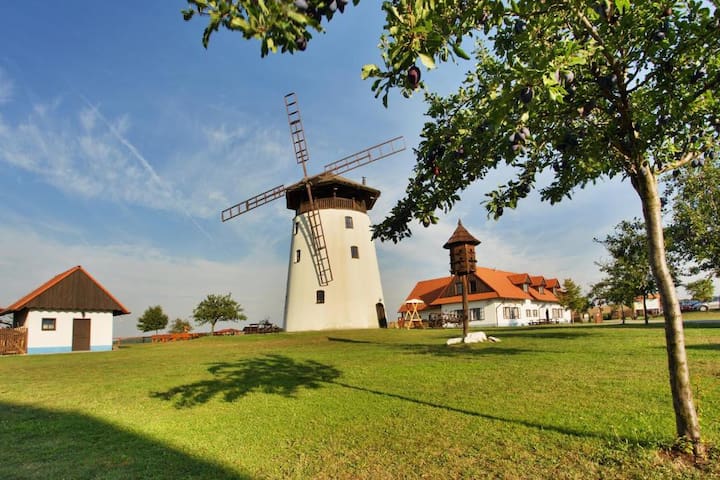Visite turistiche
This is a place meant for water sports from paddleboards to kayaks, hiking, swimming, eating ice cream, meeting friends and family picnics. You can get to the reservoir by car, by bike or by Brno public transport. It also has regular ship transport, which uses eco-friendly electric power. You can enjoy a trip on a steamer, whether you are here on a family trip or a date for two.
At nearly all docks there are restaurants and beer gardens that will entice you to have a cold beer. Or perhaps you prefer beaches and swimming? The farthest you can get by steamer is up to Veveří Castle across the entire reservoir, and after exploring it you can follow the red tourist route lining the shore back to the main dock in Bystrc. (The distance is approximately 8 kilometres.)
And there’s one thing we must not forget! Every June for many years now, the major international fireworks competition Ignis Brunensis has been held on the surface. It’s an amazing experience, so come right in. And not just to see the fireworks...
Brno Reservoir
This is a place meant for water sports from paddleboards to kayaks, hiking, swimming, eating ice cream, meeting friends and family picnics. You can get to the reservoir by car, by bike or by Brno public transport. It also has regular ship transport, which uses eco-friendly electric power. You can enjoy a trip on a steamer, whether you are here on a family trip or a date for two.
At nearly all docks there are restaurants and beer gardens that will entice you to have a cold beer. Or perhaps you prefer beaches and swimming? The farthest you can get by steamer is up to Veveří Castle across the entire reservoir, and after exploring it you can follow the red tourist route lining the shore back to the main dock in Bystrc. (The distance is approximately 8 kilometres.)
And there’s one thing we must not forget! Every June for many years now, the major international fireworks competition Ignis Brunensis has been held on the surface. It’s an amazing experience, so come right in. And not just to see the fireworks...
The castle, perched on a promontory above the confluence of the Svratka River and the Veverka stream, was probably built at the end of the 12th century and the beginning of the 13th century as a hunting castle for the pastime of Moravian margraves.
After the World War II, the communist regime misused the castle with several attempts to exploit the area in a completely inappropriate way. It was not until the end of the 20th century that systematic work on its gradual restoration began. However, this is a mission that will last many, many years.
Nevertheless, a tour of the castle is worth it even now. You can get up to the castle’s entrance gate by car, but you can also reach it on foot from the other side, by following the red tourist marker from the pier on the right shore of the Brno Reservoir. Speaking of the pier and the reservoir – you can go as far as the castle by steamer within Brno public transport. Only in summer though, because the steamer is not an icebreaker. Kids love it and you would do anything for them, wouldn’t you?
You can go on a self-guided tour through all the courtyards free of charge. But people who like to hear a guide talking can choose from two circuits, one of which is quite physically demanding. In the hall behind the castle treasury, you can see an exhibition of painted coats of arms of the owners of the Veveří Castle and an exhibition of replicas of weapons from the Thirty Years’ War. In the passage of the English Tract, you will see drawings showing the restoration of castles and their ruins in the valley of the Svratka River. The exhibition is called Copuli Lapidum.
The most comfortable way to return to Brno from the castle is by steamer again. Especially when the castle wine shop and kids running around the large castle have made you tired.
Veveří Castle
The castle, perched on a promontory above the confluence of the Svratka River and the Veverka stream, was probably built at the end of the 12th century and the beginning of the 13th century as a hunting castle for the pastime of Moravian margraves.
After the World War II, the communist regime misused the castle with several attempts to exploit the area in a completely inappropriate way. It was not until the end of the 20th century that systematic work on its gradual restoration began. However, this is a mission that will last many, many years.
Nevertheless, a tour of the castle is worth it even now. You can get up to the castle’s entrance gate by car, but you can also reach it on foot from the other side, by following the red tourist marker from the pier on the right shore of the Brno Reservoir. Speaking of the pier and the reservoir – you can go as far as the castle by steamer within Brno public transport. Only in summer though, because the steamer is not an icebreaker. Kids love it and you would do anything for them, wouldn’t you?
You can go on a self-guided tour through all the courtyards free of charge. But people who like to hear a guide talking can choose from two circuits, one of which is quite physically demanding. In the hall behind the castle treasury, you can see an exhibition of painted coats of arms of the owners of the Veveří Castle and an exhibition of replicas of weapons from the Thirty Years’ War. In the passage of the English Tract, you will see drawings showing the restoration of castles and their ruins in the valley of the Svratka River. The exhibition is called Copuli Lapidum.
The most comfortable way to return to Brno from the castle is by steamer again. Especially when the castle wine shop and kids running around the large castle have made you tired.
The zoological expedition to Mniší Hora (Monk Hill) in Brno will excite and tire even the most active child in the world. Children and adults alike will imitate the cute local meerkats.
You will find stylish houses with thatched roofs in the African village at the very top of the hill. They are made in exactly the same way as the villagers in the African savannah have been making them for ages. Some buildings are indoor dwellings for flamingos, lemurs and similar animals, while others prepare snacks, including hot meals, for hungry visitors. But most importantly, there is a safari enclosure with animals ranging from zebras to giraffes. As you eat, you can spend time together...
Hardly any zoo has such a luxurious Kamchatka brown bear enclosure. The animals are happy here and frolic while having their meals, so do not miss their regular feeding hours. The keepers have an extra portion of understanding for misbehaviour here. Every now and then, you will find a sign saying that if you meet a runaway animal, it is all right and there is no need to worry – the animals will get back to their enclosures by themselves.
Mniší Hora is a genuine piece of nature and it operates in wonderful symbiosis with its animal inhabitants. Whenever possible, the route leads in close proximity to rare species without fences and barriers. Children hardly know what to do first here – the rope centre, the playground with creative attractions carved to resemble animals, or the domestic corner with goats begging for granules from the vending machine.
When planning a trip to the Brno Zoo, ideally let it be for the whole day. You will be in the fresh air in the forest, moving all the time and the sight of cute cubs of all kinds will definitely make you smile.
To visit ZOO Brno, you can use the BrnoPas, which brings you tips for interesting places, discounts on admission and many other benefits, including transport around Brno free of charge.
24 Recomendado por los habitantes de la zona
Zoo de Brno
46 U Zoologické zahradyThe zoological expedition to Mniší Hora (Monk Hill) in Brno will excite and tire even the most active child in the world. Children and adults alike will imitate the cute local meerkats.
You will find stylish houses with thatched roofs in the African village at the very top of the hill. They are made in exactly the same way as the villagers in the African savannah have been making them for ages. Some buildings are indoor dwellings for flamingos, lemurs and similar animals, while others prepare snacks, including hot meals, for hungry visitors. But most importantly, there is a safari enclosure with animals ranging from zebras to giraffes. As you eat, you can spend time together...
Hardly any zoo has such a luxurious Kamchatka brown bear enclosure. The animals are happy here and frolic while having their meals, so do not miss their regular feeding hours. The keepers have an extra portion of understanding for misbehaviour here. Every now and then, you will find a sign saying that if you meet a runaway animal, it is all right and there is no need to worry – the animals will get back to their enclosures by themselves.
Mniší Hora is a genuine piece of nature and it operates in wonderful symbiosis with its animal inhabitants. Whenever possible, the route leads in close proximity to rare species without fences and barriers. Children hardly know what to do first here – the rope centre, the playground with creative attractions carved to resemble animals, or the domestic corner with goats begging for granules from the vending machine.
When planning a trip to the Brno Zoo, ideally let it be for the whole day. You will be in the fresh air in the forest, moving all the time and the sight of cute cubs of all kinds will definitely make you smile.
To visit ZOO Brno, you can use the BrnoPas, which brings you tips for interesting places, discounts on admission and many other benefits, including transport around Brno free of charge.
The Klucanina lookout tower stands on the hill of the same name. It is made of bricks, solid and almost thirty metres high. Thanks to its height, it offers breathtaking views in all directions. You cannot get them effortlessly, however: in order to truly deserve them, you must first climb one hundred and thirty stairs. You will be rewarded by the view of Tišnov and its wide surroundings. You will also see Babí Lom (Old Woman’s Quarry) and the Sýkoř hill. On the highest viewing platform, information boards will tell you the names of the objects which you can see around you.
You can visit the lookout tower free of charge and all year round. You can get to it on foot along the blue hiking trail which leads from the hospital in Tišnov. During the 1.5 kilometre journey, you can notice blooms of the lady’s-slipper orchid, one of the most beautiful and rarest flowers in Europe! This lovely orchid is in blossom from May to June.
lookout Klucanina
The Klucanina lookout tower stands on the hill of the same name. It is made of bricks, solid and almost thirty metres high. Thanks to its height, it offers breathtaking views in all directions. You cannot get them effortlessly, however: in order to truly deserve them, you must first climb one hundred and thirty stairs. You will be rewarded by the view of Tišnov and its wide surroundings. You will also see Babí Lom (Old Woman’s Quarry) and the Sýkoř hill. On the highest viewing platform, information boards will tell you the names of the objects which you can see around you.
You can visit the lookout tower free of charge and all year round. You can get to it on foot along the blue hiking trail which leads from the hospital in Tišnov. During the 1.5 kilometre journey, you can notice blooms of the lady’s-slipper orchid, one of the most beautiful and rarest flowers in Europe! This lovely orchid is in blossom from May to June.
The chateau is situated about twenty kilometres west of Brno. Originally, it was a medieval Gothic castle used for defence, but it is a beautiful and elegant chateau today. You can have a history lesson with your children in the chateau, where visitors will see some Renaissance elements (such as sgraffitos on the facade), as well as the Baroque and the Classicist styles (for example, the paintings in the chapel).
We have mentioned an anti-nuclear shelter and you will indeed see one during the tour. Alternatively, you may choose the other circuit and visit the chapel and the decorated chambers. The permanent exhibition of toys includes items dating from the 1950s to the present day.
There is something going on here in all seasons: knightly tournaments, Easter performances, an evening tour in costumes or the popular Garlic Fest in September – an “aromatic” festival celebrating garlic in all its forms.
You will also feel at ease in the beautiful garden, and when enjoying the wonderful view of the confluence of the Bobrava River with the Říčanský Stream!
chateau Rosice
1 Žerotínovo nám.The chateau is situated about twenty kilometres west of Brno. Originally, it was a medieval Gothic castle used for defence, but it is a beautiful and elegant chateau today. You can have a history lesson with your children in the chateau, where visitors will see some Renaissance elements (such as sgraffitos on the facade), as well as the Baroque and the Classicist styles (for example, the paintings in the chapel).
We have mentioned an anti-nuclear shelter and you will indeed see one during the tour. Alternatively, you may choose the other circuit and visit the chapel and the decorated chambers. The permanent exhibition of toys includes items dating from the 1950s to the present day.
There is something going on here in all seasons: knightly tournaments, Easter performances, an evening tour in costumes or the popular Garlic Fest in September – an “aromatic” festival celebrating garlic in all its forms.
You will also feel at ease in the beautiful garden, and when enjoying the wonderful view of the confluence of the Bobrava River with the Říčanský Stream!
Porta Coeli in Předklášteří is one of the most significant architectural monuments in the Czech Republic. When you visit it, you will realize why. As early as the 13th century, it was founded as a Cistercian monastery for women by Queen Constance. She is also buried here with her son Přemysl. A community of Cistercian sisters still lives here today.
The Gothic portal with rich ornamentation in the western facade will take your breath away. The Chapter hall, where you can see a reading desk made of stone, is one of the most precious parts of the monastery. The atmosphere is so convincing that after a while you will feel as if you can see a nun in a modest robe bending over a precious book.
In addition to the well-maintained Romanesque-Gothic core with a unique portal, other buildings have been preserved to this day, too: a Baroque granary, a former brewery, several gardens and parts of the fortification wall. In addition to the timelessly beautiful Gothic style and the oldest Romanesque style, the complex also shows the other main styles: visitors enter through a Baroque gate, see the above-mentioned Romanesque-Gothic core and admire the Gothic, Renaissance and Baroque styles on other building extensions.
There are guided tours through the Gothic core of the monastery every hour (a minimum of three visitors required). You can see a church, a Chapter hall and a beautiful cloister with a garden of paradise, which will bring even non-believers into a state of contemplation. There are four permanent exhibitions and numerous seasonal exhibitions in the Podhorácké Museum located in the building of the former provost’s office.
We recommend that you complete your meditation with a worldly and pleasant visit to the Monastery Café or Monastery Brewery!
Porta Coeli
Porta CoeliPorta Coeli in Předklášteří is one of the most significant architectural monuments in the Czech Republic. When you visit it, you will realize why. As early as the 13th century, it was founded as a Cistercian monastery for women by Queen Constance. She is also buried here with her son Přemysl. A community of Cistercian sisters still lives here today.
The Gothic portal with rich ornamentation in the western facade will take your breath away. The Chapter hall, where you can see a reading desk made of stone, is one of the most precious parts of the monastery. The atmosphere is so convincing that after a while you will feel as if you can see a nun in a modest robe bending over a precious book.
In addition to the well-maintained Romanesque-Gothic core with a unique portal, other buildings have been preserved to this day, too: a Baroque granary, a former brewery, several gardens and parts of the fortification wall. In addition to the timelessly beautiful Gothic style and the oldest Romanesque style, the complex also shows the other main styles: visitors enter through a Baroque gate, see the above-mentioned Romanesque-Gothic core and admire the Gothic, Renaissance and Baroque styles on other building extensions.
There are guided tours through the Gothic core of the monastery every hour (a minimum of three visitors required). You can see a church, a Chapter hall and a beautiful cloister with a garden of paradise, which will bring even non-believers into a state of contemplation. There are four permanent exhibitions and numerous seasonal exhibitions in the Podhorácké Museum located in the building of the former provost’s office.
We recommend that you complete your meditation with a worldly and pleasant visit to the Monastery Café or Monastery Brewery!
Climbing up the lookout tower is quite physically demanding, but the reward you get is really worth it: a scenic view of the Drahanská Highland, Ždárské Hills, wooded hills of Chřiby and more. In the south, you can see Brno and that town’s Špilberk Castle.
The lookout tower is accessible 24/7 and it is free of charge. A sign above the entrance to the lookout tower bluntly warns you that the place is haunted. But the lookout tower also has a good spirit, which you can meet there in person when the weather is good. It is an elderly gentleman with a bubble blower he has made himself!
How can you get to the lookout tower? Follow the red tourist marker from Lelekovice (it is quite a steep path across a beautiful forest) or go along the blue hiking trail from the village of Podlesí-Kuřim. If you want to go on a longer trip, start in Vranov u Brna, go along the red hiking trail towards the U Jelínka (At the Little Stag) crossroads, across the so-called Lelkovadlo, the Babí Lom crossroads and then straight to the lookout tower (approximately four hundred metres).
Babí lom Observation Tower
Climbing up the lookout tower is quite physically demanding, but the reward you get is really worth it: a scenic view of the Drahanská Highland, Ždárské Hills, wooded hills of Chřiby and more. In the south, you can see Brno and that town’s Špilberk Castle.
The lookout tower is accessible 24/7 and it is free of charge. A sign above the entrance to the lookout tower bluntly warns you that the place is haunted. But the lookout tower also has a good spirit, which you can meet there in person when the weather is good. It is an elderly gentleman with a bubble blower he has made himself!
How can you get to the lookout tower? Follow the red tourist marker from Lelekovice (it is quite a steep path across a beautiful forest) or go along the blue hiking trail from the village of Podlesí-Kuřim. If you want to go on a longer trip, start in Vranov u Brna, go along the red hiking trail towards the U Jelínka (At the Little Stag) crossroads, across the so-called Lelkovadlo, the Babí Lom crossroads and then straight to the lookout tower (approximately four hundred metres).
This modern lookout tower was built near the village of Hlína close to Ivančice and it was named after the beloved Czech actor Vladimír Menšík who was born in Ivančice. The lookout tower is twenty-two metres high and it stands on the site of the oldest lookout tower in South Moravia, at an altitude of 450 metres.
You can see the Pavlov Hills, the White Carpathians and even the peaks of the Alps from the viewing platform when the weather is good (which is only a few times a year). The lookout tower is open all year round, but visiting days vary depending on the month. You should check the opening times before you make a visit. Entrance to the lookout tower costs a few crowns, but the views are definitely worth it.
Rozhledna Vladimíra Menšíka na Hlíně
2 VýhonThis modern lookout tower was built near the village of Hlína close to Ivančice and it was named after the beloved Czech actor Vladimír Menšík who was born in Ivančice. The lookout tower is twenty-two metres high and it stands on the site of the oldest lookout tower in South Moravia, at an altitude of 450 metres.
You can see the Pavlov Hills, the White Carpathians and even the peaks of the Alps from the viewing platform when the weather is good (which is only a few times a year). The lookout tower is open all year round, but visiting days vary depending on the month. You should check the opening times before you make a visit. Entrance to the lookout tower costs a few crowns, but the views are definitely worth it.
Terrain cycling is enjoyed by more and more enthusiasts. The faster you go down the single track, the more your adrenaline level rises. And then the silence when you stop in the middle of a forest. Ten kilometres of trails at three difficulty levels, a pump track and cycling facilities. Available at any time and free of charge. All of that less than three kilometres from the town centre, for kids as well as for adults.
The Singltrek Centrum is the starting point. It is a building from which the trails originate into different circuits. You can easily get back thanks to two backbone routes. You can find showers and refreshments here, as well as a bike rental where you can borrow the right bike for a small sum of money. Going along the trail with a road bike or a city bike is not recommended.
You will learn to use “pumping” (moving up and down) to generate speed instead of pedalling. Balance, bike control, jumps – training is safe and effective on the terrain bumps of the pump track. Come and improve your skills on the Boskovice trails!
Sportpark Boskovice
Terrain cycling is enjoyed by more and more enthusiasts. The faster you go down the single track, the more your adrenaline level rises. And then the silence when you stop in the middle of a forest. Ten kilometres of trails at three difficulty levels, a pump track and cycling facilities. Available at any time and free of charge. All of that less than three kilometres from the town centre, for kids as well as for adults.
The Singltrek Centrum is the starting point. It is a building from which the trails originate into different circuits. You can easily get back thanks to two backbone routes. You can find showers and refreshments here, as well as a bike rental where you can borrow the right bike for a small sum of money. Going along the trail with a road bike or a city bike is not recommended.
You will learn to use “pumping” (moving up and down) to generate speed instead of pedalling. Balance, bike control, jumps – training is safe and effective on the terrain bumps of the pump track. Come and improve your skills on the Boskovice trails!
At the height of Malá Haná and Drahanská Highlands, the romantic ruins of the Gothic-Renaissance Boskovice Castle rise at an altitude of 460 meters above sea level. Since 1975, the castle has been undergoing a gradual reconstruction, which has resulted in access to a large part of the castle ruins.
Boskovice Castle welcomes visitors with a round tower with a renaissance battlement. The walls of the castle palace has been preserved from the originally massive building, offering an impressive view of the local picturesque landscape. The technical interest is a 26 meter deep well powered by a wooden pedal wheel, the only functional in the country. A gradual reconstruction has been underway since 1975, the result of which is the opening of a large part of the castle ruins.
From the history of the castle: the history of the castle began in the middle of the 13th century. At that time it belonged to the family of the lords of Boskovice, who owned the castle and the manor until the end of the 14th century. At the end of the 14th century, the castle passed into the possession of the lords of Kunštát. At this time, the construction of a new medieval mansion was probably started. From the 1950s, the castle together with the Boskovice estate was again held by the lords of Boskovice, until the 16th century, when it was acquired by the Eder family from Štiavnica and later by the Polish Morkovský family from Zástřizl.
At the end of the 17th century, the Dietrichsteins acquired the castle. At this time there was a decline of the castle, which was replaced by a new residence in the city. The castle definitely lost its function after 1733 and began to fall into disrepair. The castle roof was demolished and the masonry was dismantled as a building material for mansions in Boskovice. In 1843, the heiress of the Boskovice estate, Theresa of Dietrichstein, married Count Alfons Mensdorff-Pouilly. Terezie died in 1856 and her inheritance thus became the property of the Mensdorf-Pouilly family, which still owns it with a break of more than forty years.
Hrad Boskovice
7 HradníAt the height of Malá Haná and Drahanská Highlands, the romantic ruins of the Gothic-Renaissance Boskovice Castle rise at an altitude of 460 meters above sea level. Since 1975, the castle has been undergoing a gradual reconstruction, which has resulted in access to a large part of the castle ruins.
Boskovice Castle welcomes visitors with a round tower with a renaissance battlement. The walls of the castle palace has been preserved from the originally massive building, offering an impressive view of the local picturesque landscape. The technical interest is a 26 meter deep well powered by a wooden pedal wheel, the only functional in the country. A gradual reconstruction has been underway since 1975, the result of which is the opening of a large part of the castle ruins.
From the history of the castle: the history of the castle began in the middle of the 13th century. At that time it belonged to the family of the lords of Boskovice, who owned the castle and the manor until the end of the 14th century. At the end of the 14th century, the castle passed into the possession of the lords of Kunštát. At this time, the construction of a new medieval mansion was probably started. From the 1950s, the castle together with the Boskovice estate was again held by the lords of Boskovice, until the 16th century, when it was acquired by the Eder family from Štiavnica and later by the Polish Morkovský family from Zástřizl.
At the end of the 17th century, the Dietrichsteins acquired the castle. At this time there was a decline of the castle, which was replaced by a new residence in the city. The castle definitely lost its function after 1733 and began to fall into disrepair. The castle roof was demolished and the masonry was dismantled as a building material for mansions in Boskovice. In 1843, the heiress of the Boskovice estate, Theresa of Dietrichstein, married Count Alfons Mensdorff-Pouilly. Terezie died in 1856 and her inheritance thus became the property of the Mensdorf-Pouilly family, which still owns it with a break of more than forty years.
Originally a Dominican monastery stood on the site of today's Boskovice chateau, which, after its abolition, briefly served as a manufactory for the production of dyes. The reconstruction of the monastery buildings into a chateau was carried out in the years 1819-1826 under František Xaver of Dietrichstein. This created one of the most charming Empire castles in Moravia, which has maintained its stylistic purity to the present day. In 1856, the chateau came into the possession of the Mensdorff-Pouilly family, which he owned until 1950 and to which it was returned in 1991.
In addition to the traditional tours of the historical installation, it is possible to organize wedding ceremonies, concerts, exhibitions and various commercial events in the attractive environment of the Empire chateau in Boskovice.
6 Recomendado por los habitantes de la zona
Chateau Boskovice
638 HradníOriginally a Dominican monastery stood on the site of today's Boskovice chateau, which, after its abolition, briefly served as a manufactory for the production of dyes. The reconstruction of the monastery buildings into a chateau was carried out in the years 1819-1826 under František Xaver of Dietrichstein. This created one of the most charming Empire castles in Moravia, which has maintained its stylistic purity to the present day. In 1856, the chateau came into the possession of the Mensdorff-Pouilly family, which he owned until 1950 and to which it was returned in 1991.
In addition to the traditional tours of the historical installation, it is possible to organize wedding ceremonies, concerts, exhibitions and various commercial events in the attractive environment of the Empire chateau in Boskovice.
If you come to the Balcarka Cave by car, there is parking available right at the cave, while if you come by bus, get off at the stop called Ostrov u Macochy, Balcarka. The trip is conceived as a circuit and which side you start from is up to you. You will experience Macocha as well, from the upper bridge – you only have to extend your visit a little. The Moravian Karst encourages exploration...
The Balcarka Cave is situated in a picturesque karst deep down near the village of Ostrov u Macochy. The underground maze of corridors, cracks and domes is spread across two underground levels. The entrance portal of the cave is a significant paleontological and archaeological site. It can only be visited as part of a guided tour, plan approximately 60 minutes for it.
After the tour of Balcarka, go along the bike trail called Through the Heart of South Moravia to the right and explore the karst village of Ostrov u Macochy. You will find a lot of small caves and sinkholes along the way, up to the signpost Ostrov – U Hřbitova (Ostrov – At the Cemetery). Here, join the red tourist marking on the left, walk past the windmill and turn right onto the green tourist trail, which leads to the Macocha abyss. When you get enough of looking into the green depth of the abyss, take the same way back, but this time turn right to the red trail at the signpost Ostrov – nad Balcarkou (Ostrov – Above the Balcarka Cave). You will get back to your car or to the bus stop, back to the Balcarka Cave.
Since they were kids, all natives of the Moravian Karst region have heard a terrifying legend about a stepmother, an evil one of course. She threw her stepchild into the abyss and jumped in right after. By a miracle, the child was saved, but on stormy days you can still hearthe mournful weeping of the stepmother from the abyss…
Macocha and the beautiful green area around it gives a mysterious, even magical impression. Just as Prague has the infamous Nuselský Bridge, the endless abyss is a place for suicides here. Dozens of people have chosen to end their lives here over the last hundred years.
But you will be enchanted by the positive influence of the surrounding nature. It is a true balm for the nerves – lush greenery, wherever you look. You can view the abyss from two bridges, the upper and the lower. The upper one looks down from a height of 138 meters, while the lower one is 92 m above the low part of the abyss and you can see the bottom very well from there. From the bridge, head to Punkva Caves via a picturesque hiking trail.
Macocha was probably formed by breaking the vault of a large underground dome, which the underground Punkva River flows through (along which you will float at the end of the tour). There are other underground spaces below the surface of the Lower Lake, so far explored up to 187.5 meters.
The Punkva Caves are situated in Pustý Žleb (Barren Deep), two kilometres from the Skalní Mlýn information centre upstream on the Punkva River. The tour consists of two parts. In the first stage, you will walk through massive domes and corridors with dripstone decoration to the bottom of the Macocha Abyss. You will experience real adrenaline in the second part as you travel along the underground Punkva River by motorboat. The cruise includes a tour of the Masaryk Dome, the most beautiful space of the Punkva Caves, although everything you have seen prior to that is worth it, too.
The caves are part of the longest cave system in the Czech Republic, the Amatérská Cave (Amateur Cave). The length of its corridors which have been discovered so far is over 30 kilometres.
For wheelchair users: visit the Front Dome in the dry part of the cave and with a little help from the guides when getting in the boat, you can also go on a cruise on the underground Punkva River. It is necessary to announce your visit beforehand by calling +420 516 418 602.
You should book the tour in advance, because it is in high demand. Don’t be sad if you cannot get to the Punkva Caves this time. Go a little further, to the Kateřinská Cave (Catherine Cave), for example.
15 Recomendado por los habitantes de la zona
Moravian Karst
If you come to the Balcarka Cave by car, there is parking available right at the cave, while if you come by bus, get off at the stop called Ostrov u Macochy, Balcarka. The trip is conceived as a circuit and which side you start from is up to you. You will experience Macocha as well, from the upper bridge – you only have to extend your visit a little. The Moravian Karst encourages exploration...
The Balcarka Cave is situated in a picturesque karst deep down near the village of Ostrov u Macochy. The underground maze of corridors, cracks and domes is spread across two underground levels. The entrance portal of the cave is a significant paleontological and archaeological site. It can only be visited as part of a guided tour, plan approximately 60 minutes for it.
After the tour of Balcarka, go along the bike trail called Through the Heart of South Moravia to the right and explore the karst village of Ostrov u Macochy. You will find a lot of small caves and sinkholes along the way, up to the signpost Ostrov – U Hřbitova (Ostrov – At the Cemetery). Here, join the red tourist marking on the left, walk past the windmill and turn right onto the green tourist trail, which leads to the Macocha abyss. When you get enough of looking into the green depth of the abyss, take the same way back, but this time turn right to the red trail at the signpost Ostrov – nad Balcarkou (Ostrov – Above the Balcarka Cave). You will get back to your car or to the bus stop, back to the Balcarka Cave.
Since they were kids, all natives of the Moravian Karst region have heard a terrifying legend about a stepmother, an evil one of course. She threw her stepchild into the abyss and jumped in right after. By a miracle, the child was saved, but on stormy days you can still hearthe mournful weeping of the stepmother from the abyss…
Macocha and the beautiful green area around it gives a mysterious, even magical impression. Just as Prague has the infamous Nuselský Bridge, the endless abyss is a place for suicides here. Dozens of people have chosen to end their lives here over the last hundred years.
But you will be enchanted by the positive influence of the surrounding nature. It is a true balm for the nerves – lush greenery, wherever you look. You can view the abyss from two bridges, the upper and the lower. The upper one looks down from a height of 138 meters, while the lower one is 92 m above the low part of the abyss and you can see the bottom very well from there. From the bridge, head to Punkva Caves via a picturesque hiking trail.
Macocha was probably formed by breaking the vault of a large underground dome, which the underground Punkva River flows through (along which you will float at the end of the tour). There are other underground spaces below the surface of the Lower Lake, so far explored up to 187.5 meters.
The Punkva Caves are situated in Pustý Žleb (Barren Deep), two kilometres from the Skalní Mlýn information centre upstream on the Punkva River. The tour consists of two parts. In the first stage, you will walk through massive domes and corridors with dripstone decoration to the bottom of the Macocha Abyss. You will experience real adrenaline in the second part as you travel along the underground Punkva River by motorboat. The cruise includes a tour of the Masaryk Dome, the most beautiful space of the Punkva Caves, although everything you have seen prior to that is worth it, too.
The caves are part of the longest cave system in the Czech Republic, the Amatérská Cave (Amateur Cave). The length of its corridors which have been discovered so far is over 30 kilometres.
For wheelchair users: visit the Front Dome in the dry part of the cave and with a little help from the guides when getting in the boat, you can also go on a cruise on the underground Punkva River. It is necessary to announce your visit beforehand by calling +420 516 418 602.
You should book the tour in advance, because it is in high demand. Don’t be sad if you cannot get to the Punkva Caves this time. Go a little further, to the Kateřinská Cave (Catherine Cave), for example.
The mill is an impressive feature dominating over the village of Bukovany and you have a wonderful view of the traditional Slovácko region from there. The Bukovany Mill is a fifteen-metre high lookout tower built in the style of a windmill of the Dutch type. From the viewing platform eleven metres above the ground you can see the surroundings of Kyjov, the White Carpathians and if the weather is good, you can even look as far as the Kobyla Hill near Bratislava. The lookout tower is connected to popular bike trails leading through the wine-growing regions, so visitors can come here on two wheels. Be prepared that your kids might refuse to ever go back home from here.
There is a sales gallery with an exhibition of utility ceramics in the interior of the mill. You can visit an exhibition featuring the history of Bukovany on the second floor. The local atmosphere will take you back to the times of the Czech people’s great-grandmothers. There is a hotel with a restaurant on the premises of the mill, where specialities of traditional Moravian Slovak and Old Czech cuisine are offered and prepared from quality ingredients. Like manna from heaven! Accompany a good meal by choosing from a fine selection of Moravian wines.
You can also try other pleasant activities: minigolf, archery or walking along a massage path which brings relief to tired feet. And that is not all. Kids will look forward to riding ponies and to a free range with friendly goats.
The whole premises are built in the traditional style of Moravian Slovakia with stylish rustic interiors and unique atmosphere. The place regularly hosts social and cultural events. Will you visit any of them?
Bukovanský mlýn
The mill is an impressive feature dominating over the village of Bukovany and you have a wonderful view of the traditional Slovácko region from there. The Bukovany Mill is a fifteen-metre high lookout tower built in the style of a windmill of the Dutch type. From the viewing platform eleven metres above the ground you can see the surroundings of Kyjov, the White Carpathians and if the weather is good, you can even look as far as the Kobyla Hill near Bratislava. The lookout tower is connected to popular bike trails leading through the wine-growing regions, so visitors can come here on two wheels. Be prepared that your kids might refuse to ever go back home from here.
There is a sales gallery with an exhibition of utility ceramics in the interior of the mill. You can visit an exhibition featuring the history of Bukovany on the second floor. The local atmosphere will take you back to the times of the Czech people’s great-grandmothers. There is a hotel with a restaurant on the premises of the mill, where specialities of traditional Moravian Slovak and Old Czech cuisine are offered and prepared from quality ingredients. Like manna from heaven! Accompany a good meal by choosing from a fine selection of Moravian wines.
You can also try other pleasant activities: minigolf, archery or walking along a massage path which brings relief to tired feet. And that is not all. Kids will look forward to riding ponies and to a free range with friendly goats.
The whole premises are built in the traditional style of Moravian Slovakia with stylish rustic interiors and unique atmosphere. The place regularly hosts social and cultural events. Will you visit any of them?

